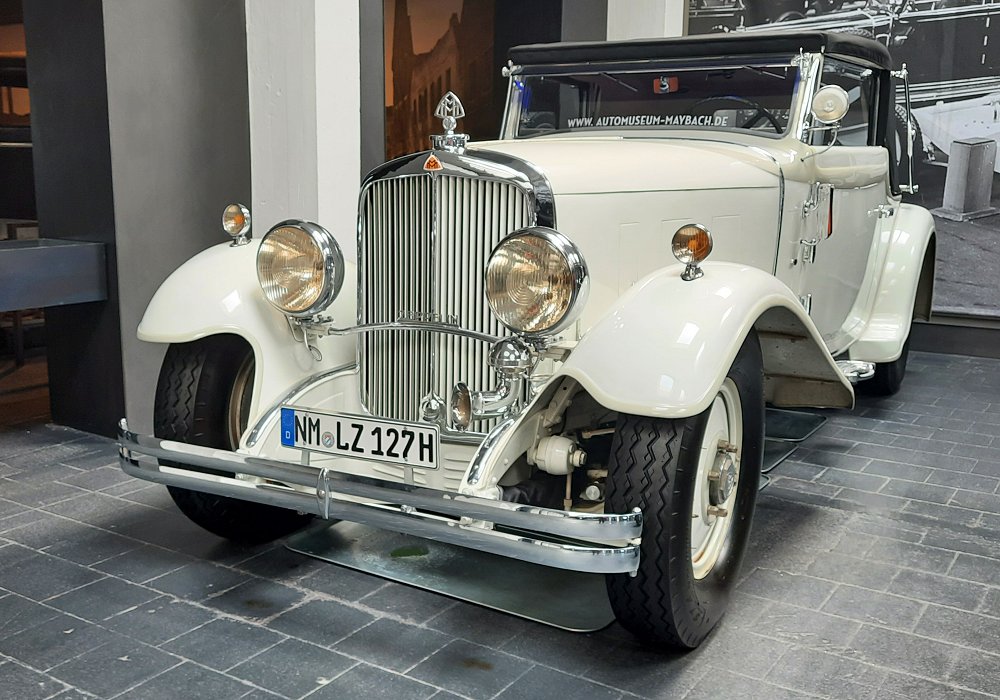Description
The Maybach DS 8 Zeppelin Sport Cabriolet by Spohn was one of the most spectacular, rare and luxurious open cars ever built in pre-war Europe. Combining Maybach’s most powerful and technically advanced chassis with Spohn’s flamboyant, beautifully executed coachwork, it represented the pinnacle of German bespoke automotive craftsmanship in the early 1930s. The Sport Cabriolet body style — lighter, more dynamic and far more glamorous than the formal limousine bodies more commonly fitted to the DS 8 — made this one of the most desirable and exclusive Maybachs of its era. Very few were ever constructed, and surviving examples rank among the most valuable classic automobiles in the world.
The DS 8 Zeppelin chassis, introduced in 1931, was the ultimate evolution of Maybach’s pre-war engineering. Under its bonnet sat an immense 8.0-litre V12 engine, one of the largest and most refined motorcar engines of its day. Producing around 200 horsepower, the V12 delivered its power with a smoothness and quiet authority unmatched by almost any competitor. The engine’s turbine-like character was a direct product of Maybach’s experience in constructing aircraft and airship engines, where mechanical balance and reliability were paramount. In a Sport Cabriolet, this vast reserve of torque gave the car exceptional performance and effortless cruising even with a large, luxurious open body.
The chassis was built on a massive, rigid ladder frame designed to support the heaviest coachwork, but it also provided an excellent foundation for more athletic configurations such as the Sport Cabriolet. Suspension consisted of long semi-elliptic leaf springs front and rear, tuned for comfort and high-speed stability. Although the DS 8 was not designed as a sporting car in the modern sense, the Sport Cabriolet body made it lighter and more responsive than the Pullman limousines and town cars typically built on the same chassis. The DS 8’s long wheelbase and careful suspension tuning allowed it to maintain smooth, composed behaviour even at speed.
Transmission was provided by Maybach’s sophisticated dual-range gearbox, offering both low-range and high-range settings for varied driving conditions. This system gave the driver a wide spread of gearing choices and allowed the DS 8 to move easily from slow city traffic to fast intercity cruising. Though still a chauffeur-level automobile, the Sport Cabriolet body style encouraged owner-driven use, and the flexibility of the transmission made the large car surprisingly manageable.
Spohn’s Sport Cabriolet bodywork was nothing short of breathtaking. Spohn was known for its mastery of flowing lines, dramatic fender shapes, and precise metalwork, and on the DS 8 chassis the workshop produced some of the most beautiful open cars of the age. The Sport Cabriolet typically featured a long hood, sweeping front wings, flowing side profiles and a gracefully tapered rear deck designed to house a fully folding soft-top. The proportions were elegant and imposing, with a hint of sporting dynamism not present in the more formal bodies of the same era. Every panel was hand-shaped in Spohn’s Ravensburg workshops, with superb craftsmanship and painstaking attention to detail.
The interior of the Sport Cabriolet was a masterpiece of bespoke luxury. Seating was designed for comfort during long touring journeys, with deep, richly upholstered leather seats, finely polished hardwood trim, precision-machined metal fittings and elegant instrumentation. Although slightly more intimate than the vast Pullman interiors, the cabin remained exceptionally opulent, with amenities such as fold-out tables, vanity compartments, custom lighting arrangements, smoking sets, and bespoke storage crafted to the customer’s tastes. With the roof lowered, the car became an open-air salon that showcased both craftsmanship and mechanical refinement.
On the road, the DS 8 Sport Cabriolet offered a driving experience unlike any other pre-war open car. The enormous V12 delivered strong, smooth acceleration, and the chassis maintained a calm, unhurried stability even at high speeds. Steering was steady and predictable, well suited to the car’s grand-touring character, and braking — via large mechanical drums — was effective for a vehicle of its size. The combination of vast power, remarkable refinement and open-air luxury gave the Sport Cabriolet a commanding presence both in motion and at rest.
Production numbers for the DS 8 were extremely limited, and only a handful of Sport Cabriolets were ever constructed by Spohn. These cars were bespoke commissions for an elite clientele, often individuals of considerable wealth or political influence. Today, surviving examples are among the rarest and most valuable pre-war automobiles in existence, coveted for their beauty, engineering and historical significance.
The Maybach DS 8 Zeppelin Sport Cabriolet Spohn stands as one of the greatest masterpieces of pre-war automotive design. It combines the majestic engineering of Maybach’s ultimate V12 chassis with Spohn’s most elegant and dramatic open-body craftsmanship. Powerful, rare, exquisitely built and visually extraordinary, it remains one of the most desirable and culturally important luxury convertibles ever created.


